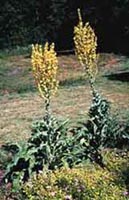Resource Library
Plant of the Week: Mullen, Common
The University of Arkansas System Division of Agriculture does not promote, support or recommend plants featured in "Plant of the Week." Please consult your local Extension office for plants suitable for your region.
Plant of the Week
Common Mullen
Latin: Verbascum thapsus

Weeds are the bane of a gardener’s existence, but sometimes even weeds can have some interesting features. Most people with good judgment consider mullen a weed, but I confess to allowing it to grow in my perennial border when it happens to appear unannounced and uninvited amongst its more showy brethren.
Mullen is a biennial that grows only leaves the first year and then flowers and dies the second year. During the first year, it can produce 18-inch long wooly gray leaves that form a bushel basket-size rosette.
When it flowers in spring of its second season, the rosette stretches out and forms a spike that grows 5 feet high. The spike will often branch at the top, producing arms shaped like those of Saguaro cactus of the Arizona desert. Its bright yellow flowers have five petals. It’s not obvious that the plant is a member of the snapdragon family.
The common mullen is not native to the United States. It’s an introduced weed from Eurasia. It was probably introduced during colonial times as a medicinal herb. It’s leaves have been used as a wrapper – kind of a botanical version of Saran Wrap – for keeping food from spoiling.
The monks of the Middle Ages grew mullen for a number of ailments, especially those associated with coughs and congestion. One of its common names was "bullocks lungwort," taken from a common home cure used to treat cattle with coughs and pneumonia. Sap from the crushed leaves of the plant is said to alleviate the pain of insect bites.
But what I find most fascinating about the common mullen is its desire to live. Back in 1879, Professor William Beal (1833-1924), a botanist at the University of Michigan, began an experiment that continues to this date. In the fall of that year, Beal collected seeds of 23 common weeds and placed them in sand in pint jars. The jars were buried on a sandy knoll in what today is the five-acre W.J. Beal Botanic Garden. Originally, the jars were dug every five years, but the number of jars began to decline, and now they’re dug up every 20 years.
The most recent set of jars was dug up in 1999. Most of the seedlings that emerged after 120 years buried in the cold Michigan soil were the moth mullen, a closely related species, but the common mullen also made its presence known. These tenacious seeds remained in a state of suspended animation for more than a century, awaiting their day in the sun.
Most of Beal’s weed species were real wimps, remaining viable for only 20 years. Only five species managed to remain viable after 50 years.
Even if you don’t consider mullen a suitable garden plant, we can learn from Professor Beal’s study. First, every shovelful of soil contains hundreds or maybe even thousands of seeds, most of which are undesirable. Gardeners should do all they can not to add to this collection by allowing weeds, or weedy flowers, to go to seed.
Second, most of these long-lived weed seeds need light to germinate, so applying a mulch as quickly after planting as possible will keep the seed in the dark and reduce the amount of weeding that will be necessary.
By: Gerald Klingaman, retired
Extension Horticulturist - Ornamentals
Extension News - May 18, 2001
The University of Arkansas System Division of Agriculture does not maintain lists of retail outlets where these plants can be purchased. Please check your local nursery or other retail outlets to ask about the availability of these plants for your growing area.